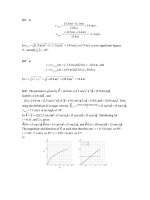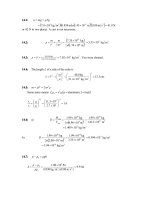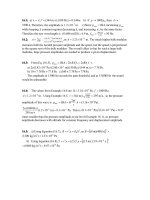- Trang chủ >>
- Khoa Học Tự Nhiên >>
- Vật lý
Tài liệu Physics exercises_solution: Chapter 21 doc
Bạn đang xem bản rút gọn của tài liệu. Xem và tải ngay bản đầy đủ của tài liệu tại đây (451.62 KB, 41 trang )
21.1:
C103.20chargeandg00.8
9
lead
m
a)
.100.2
C106.1
C1020.3
10
19
9
e
n
b)
.1058.8and1033.2
207
g00.8
13
lead
e
22
lead
n
n
Nn
A
21.2:
s10s100andsC000,20current
4
t
Q = It = 2.00 C
.1025.1
C1060.1
19
19
e
Q
n
21.3: The mass is primarily protons and neutrons of
27
1067.1
m
kg, so:
28
27
nandp
1019.4
kg101.67
kg70.0
n
About one-half are protons, so
e
28
p
1010.2 nn
and the charge on the electrons is
given by:
.C1035.3)1010.2(C)1060.1(
92819
Q
21.4: Mass of gold = 17.7 g and the atomic weight of gold is 197
mol.g
So the
number of atoms
.1041.5)1002.6(mol
22
molg197
g7.17
23
A
N
a)
2422
p
1027.41041.579 n
C106.83C1060.1
519
p
nq
b)
.1027.4
24
pe
nn
21.5:
.electrons101.08atomsH106.021.80mol80.1
2423
C.101.73C1060.1101.08charge
51924
21.6: First find the total charge on the spheres:
C1043.1)2.0)(1057.4(44
4
1
16221
0
2
0
2
2
0
πεFrπεq
r
q
πε
F
And therefore, the total number of electrons required is
890.C101.60C1043.1
1916
eqn
21.7: a) Using Coulomb’s Law for equal charges, we find:
.C1042.7C105.5
m)150.0(4
1
N220.0
7213
2
2
0
q
q
πε
F
b) When one charge is four times the other, we have:
C1071.3C10375.1
m)150.0(
4
4
1
N220.0
7213
2
2
0
q
q
πε
F
So one charge is
7
1071.3
C, and the other is
C.10484.1
6
21.8: a) The total number of electrons on each sphere equals the number of protons.
.1025.7
molkg026982.0
kg0250.0
13
24
pe
A
Nnn
b) For a force of
4
1000.1
N to act between the spheres,
.C1043.8m)08.0(N)10(4
4
1
N10
424
0
2
2
0
4
πεq
r
q
πε
F
15
e
1027.5
eqn
c)
10
e
107.27is
n
of the total number.
21.9: The force of gravity must equal the electric force.
.m08.5m8.25
)sm8.9(kg)1011.9(
C)1060.1(
4
1
4
1
2
31
219
0
2
2
2
0
r
πε
r
r
q
πε
mg
21.10: a) Rubbing the glass rod removes electrons from it, since it becomes positive.
kg.1027.4)electronkg1011.9(electrons)104.69(
electrons1069.4)Celectrons1025.6(C)107.50(nC50.7
203110
10189
The rods mass decreases by
kg.1027.4
20
b) The number of electrons transferred is the same, but they are added to the mass of
the
plastic rod, which increases by
kg.1027.4
20
21.11:
positive.isanddirection-theinbemustsodirection,-theinis
112
qxx FF
nC750.00400.00200.0
,
2
2
1
2
23
32
2
13
31
21
r
k
r
kFF
21.12: a)
2
2
6
0
2
21
0
m)30.0(
C)10550.0(
4
1
N200.0
4
1
q
πεr
πε
F
C.1064.3
6
2
q
b)
200.0F
N, and is attractive.
21.13: Since the charges are equal in sign the force is repulsive and of magnitude:
N172.0
m)800.0(4
C)1050.3(
2
0
26
2
2
πεr
kq
F
21.14: We only need the y-components, and each charge contributes equally.
0.6).sinsince(N173.0sin
m)500.0(
C)104(C)100.2(
4
1
2
66
0
αα
πε
F
Therefore, the total force is
N35.02 F
, downward.
21.15:
theinbothareand
32
FF
x-direction.
N10124.1,N10749.6
4
2
13
31
3
5
2
12
21
2
r
kF
r
kF
thein,N108.1
4
32
FFF
x-direction.
21.16:
N100.0
m60.0
C)100.2(C)10.20()CmN109(
2
66229
21
F
1Q
F
is equal and opposite to
Q
F
1
(Ex. 21.4), so
N17.0
N23.0
1
1
y
Q
x
Q
F
F
Overall:
N27.0N17.0N100.0
N23.0
y
x
F
F
The magnitude of the total force is
N.35.0N27.0N23.0
22
The direction of
the force, as measured from the +y axis is
40
27.0
23.0
tan
1
θ
21.17:
2
F
is in the
direction. x
N10.37N37.3N00.7
N00.7and
N37.3so ,N37.3
23
32
2
2
12
21
2
xxx
xxxx
x
FFF
FFFF
F
r
kF
For
x
F
3
to be negative,
3
q
must be on the –x-axis.
m144.0so m,144.0so ,
3
31
2
31
3
x
F
qqk
x
x
kF
21.18: The charge
3
q
must be to the right of the origin; otherwise both
32
and qq
would
exert forces in the + x direction. Calculating the magnitude of the two forces:
direction.in theN375.3
m)200.0(
C)1000.5C)(1000.3)(CmN109(
4
1
2
66229
2
12
21
0
21
x
r
πε
F
directionthein
mN216.0
C)1000.8(C)1000.3()CmN109(
2
13
2
2
13
66239
31
x
r
r
F
We need
:N00.7
3121
FF
N00.7
mN0.216
N375.3
2
13
2
r
origintheofrightthetom144.0
m0208.0
N7.00N3.375
mN216.0
13
2
2
2
13
r
r
21.19:
1221
and FFF FFF
since they are acting in the same direction at
m400.0y
so,
downward.N1059.2
m)400.0(
C1020.3
m)200.0(
C1050.1
C)1000.5(
4
1
6
2
9
2
9
9
0
πε
F
21.20:
2121
and FFF FFF
since they are acting in opposite directions at
x = 0 so,
right.thetoN104.2
m)300.0(
C1000.5
m)200.0(
C1000.4
C)1000.6(
4
1
6
2
9
2
9
9
0
πε
F
21.21: a)
b)
2322
0
22
0
)(
2
4
1
sin
)(
4
1
2,0
xa
qQa
πε
θ
xa
πε
FF
yx
c)
direction.thein
2
4
1
,0At
2
0
y
a
πε
Fx
y
d)
21.22: a)
b)
0,
)(
2
4
1
cos
)(
4
1
2
2/322
0
22
0
yx
F
xa
qQx
πε
θ
xa
πε
F
c) At x = 0, F = 0.
d)
21.23:
b)
thebelow45ofangleanat
24
1
221
4
1
2
24
1
2
2
0
2
2
0
2
2
0
L
q
πεL
q
πεL
q
πε
F
positive
x-axis
21.24: a)
particle.thetowarddown,CN432
m)250.0(
C)1000.3(
4
1
4
1
2
9
0
2
0
πεr
q
πε
E
b)
m.50.1
)CN0.12(
C)1000.3(
4
1
4
1
CN00.12
9
0
2
0
πε
r
r
q
πε
E
21.25: Let +x-direction be to the right. Find
:
x
a
CN5.23C)10602.1(2N)10516.7(
left.thetoissopositive,ischarge,direction-leftthetois
N10516.7
sm101.132gives
?,s1065.2,sm101.50,sm1050.1
1918
18
29
0
633
0
qFE
x
maF
atavv
atvv
xx
xxxx
xxx
EF
21.26: (a)
2
2
1
atx
CN69.5
C106.1
)sm101.00(kg)1011.9(
sm1000.1
s)103.00(
m)50.4(2
2
19
2
1231
2
12
26-2
q
ma
q
F
E
t
x
a
The force is up, so the electric field must be downward since the electron is negative.
(b) The electron’s acceleration is ~
11
10
g, so gravity must be negligibly small
compared to the electrical force.
21.27: a)
negative.issign,C1019.2
CN650
)sm8.9(kg)00145.0(
5
2
qmgEq
b)
upward.C,/N1002.1
C101.60
)sm9.8(kg)1067.1(
7
19
227
EmgqE
21.28: a)
.CN1004.1
m)1000.6(
C)1060.126(
4
1
4
1
11
210
19
0
2
0
πεr
q
πε
E
b)
.CN1015.5
m)1029.5(
C)1060.1(
4
1
4
1
11
211
19
0
2
0
proton
πεr
q
πε
E
21.29: a)
Fq andC,100.55
6
is downward with magnitude
C,N1013.1Therefore,N.1020.6
49
qFE
upward.
b) If a copper nucleus is placed at that point, it feels an upward force of magnitude
N.105.24CN101.13C106.129
22419
qEF
21.30: a) The electric field of the Earth points toward the ground, so a NEGATIVE
charge will hover above the surface.
C.92.3
CN150
)sm8.9(kg)0.60(
2
qqEmg
b)
N.1038.1
m)00.100(
C)92.3(
4
1
4
1
7
2
2
0
2
2
0
πεr
q
πε
F
The magnitude of the charge is
too great for practical use.
21.31: a) Passing between the charged plates the electron feels a force upward, and just
misses the top plate. The distance it travels in the y-direction is 0.005 m. Time of flight
s1025.1
8
sm1060.1
m0200.0
6
t
and initial y-velocity is zero. Now,
.sm1040.6s)1025.1(m005.0so
2
1328
2
1
2
2
1
0
aaattvy
y
But also
.CN364
C1060.1
)sm1040.6kg)(1011.9(
19
2
1331
Ea
e
m
eE
m
F
b) Since the proton is more massive, it will accelerate less, and NOT hit the plates.
To find the vertical displacement when it exits the plates, we use the kinematic equations
again:
m.1073.2s)1025.1(
2
1
2
1
628
p
2
m
eE
aty
c) As mention in b), the proton will not hit one of the plates because although the
electric force felt by the proton is the same as the electron felt, a smaller acceleration
results for the more massive proton.
d) The acceleration produced by the electric force is much greater than g; it is
reasonable to ignore gravity.
21.32: a)
jjE
ˆ
)CN10813.2(
m0400.0
C)1000.5()CmN109(
ˆ
4
4
2
9229
2
10
1
1
rπε
q
CN1008.1
m)0400.0(0.0300m
C)1000.3()CmN109(
4
2
2
9229
2
2
2
2
r
q
E
The angle of
,
2
E
measured from the
axis,-x
is
9.126tan180
cm3.00
cm00.4
1
Thus
ji
jiE
ˆ
)CN10(8.64
ˆ
)CN106.485(
)9.126sin
ˆ
9.126cos
ˆ
()CN10080.1(
33
4
2
b) The resultant field is
ji
jiEE
ˆ
)CN1095.1(
ˆ
)C/N10485.6(
ˆ
)CN1064.8C/N10813.2(
ˆ
)CN10485.6(
43
343
21
21.33: Let
x
be to the right and
y
be downward.
Use the horizontal motion to find the time when the electron emerges from the
field:
sm1079.1
sm1000.8gives
2
?,s1025.1,0m,0.0050
sm1060.1
s1025.1gives
?,sm1060.1,0,m0200.0
622
5
0
0
8
0y0
6
82
2
1
00
6
00
yx
y
yy
y
x
xx
xx
vvv
vt
vv
yy
vtvyy
v
ttatvxx
tvaxx
21.34: a)
.CN8.17)14()11(so ,
ˆ
CN14
ˆ
CN11
22
EjiE
128so ,8.51)1114(tan
1
θθ
counterclockwise from the x-axis
b)
)repulsive(52at)iN,1045.4)C105.2()CN8.17(so
89
FqEF
).repulsive(128at)ii
21.35: a)
eEFgmF
e
30
2
31
eg
.N1093.8)sm(9.8kg)1011.9(
.N1060.1)CN1000.1()C1060.1(
15419
Yes, ok to neglect
g
F
because
.
ge
FF
b)
kg1063.1N106.1CN10
1615
e
4
mmgFE
.101.79
e
14
mm
c) No. The field is uniform.
21.36: a)
.CN148
)1050.1()C1060.1(
)kg1067.1()m0160.0(2
2
1
2
1
2619
27
22
s
Et
m
eE
atx
p
b)
.sm1013.2
4
0
t
m
eE
atvv
p
21.37: a)
jr
ˆ
,
20
35.1
tan
1
π
b)
jir
ˆ
2
2
ˆ
2
2
ˆ
,
42.
12
tan
1
π
c)
jir
ˆ
92.0
ˆ
39.0
ˆ
,112.9radians97.1
10.1
6.2
tan
1
(Second quadrant).
21.38: a)
.N1082.9,CN614
17
qEFE
b)
.N103.2)100.1(4
8210
0
2
πεeF
c) Part (b) >> Part (a), so the electron hardly notices the electric field. A person in
the electric field should notice nothing if physiological effects are based solely on
magnitude.
21.39: a) Let
x
be east.
E
is west and
q
is negative, so
F
is east and the electron speeds up.
sm1033.6gives)(2
?m,375.0,sm10638.2,sm1050.4
sm10638.2)kg10109.9()N10403.2(
N10403.2)mV50.1()C10602.1(||
5
0
2
0
2
0
2115
0
2113119
1919
xxxx
xxx
xx
x
vxxavv
vxxav
mFa
EqF
b)
F
so0q
is west and the proton slows down.
sm1059.1gives)(2
?,m375.0,sm10436.1,sm1090.1
sm10436.1)kg10673.1()N10403.2(
N10403.2)mV50.1()C10602.1(||
4
0
0
22
0
2
84
0
2
82719
1919
xx
xx
xxx
xx
x
vxxavv
vxxav
mFa
EqF
21.40: Point charges
1
q
(0.500 nC) and
2
q
(8.00 nC) are separated by
.m20.1x
The
electric field is zero when
2
11
2
12
)20.1(
21
)2.1(
2
1
2
2
1
1
rqrqEE
r
kq
r
kq
72.02.17.5or 0)2.1()2.1(2)(2.1)2.1(2
1
2
11
2
11
2
1121
2
11
2
11
rrqrqrqqqrqrq
24.0 4.0,24.0
11
rr
is the point between.
21.41: Two positive charges,
q
, are on the x-axis a distance a from the origin.
a) Halfway between them,
.0E
b) At any position
ax
xa
q
xa
q
πε
ax
xa
q
xa
q
πε
ax
xa
q
xa
q
πε
Ex
,
)()(4
1
,
)()(4
1
|| ,
)()(4
1
,
22
0
22
0
22
0
For graph, see below.
21.42: The point where the two fields cancel each other will have to be closer to the
negative charge, because it is smaller. Also, it cant’t be between the two, since the two
fields would then act in the same direction. We could use Coulomb’s law to calculate the
actual values, but a simpler way is to note that the 8.00 nC charge is twice as large as the
–4.00 nC Charge. The zero point will therefore have to be a factor of
2
farther from the
8.00 nC charge for the two fields to have equal magnitude. Calling
x
the distance from
the –4.00 nC charge:
m90.2
220.1
x
xx
21.43: a) Point charge
1
q
(2.00 nC) is at the origin and
nC00.5(
2
q
) is at
.m800.0x
i) At
right.CN575
m)600.0(
||
m)200.0(
||
,m200.0
2
2
2
1
qkqk
Ex
ii) At
left.CN269
m)20.1(
||
m)400.0(
||
,m20.1
2
1
2
2
qkqk
Ex
iii) At
left.CN405
m)00.1(
||
m)200.0(
||
,m200.0
2
2
2
1
qkqk
Ex
b)
FFeEF )ii left,N102.9CN575C106.1i)
1719
right.N1048.6405106.1iii) right,N103.4CN269C106.1
17191719
F
21.44: A positive and negative charge, of equal magnitude
q
, are on the x-axis, a
distance
a
from the origin.
a) Halfway between them,
,
2
4
1
2
0
a
q
πε
E
to the left.
b) At any position
ax
xa
q
xa
q
πε
ax
xa
q
xa
q
πε
ax
xa
q
xa
q
πε
Ex
,
)()(4
1
,
)()(4
1
|| ,
)()(4
1
,
22
0
22
0
22
0
with “+” to the right.
This is graphed below.
21.45: a) At the origin,
.0E
b) At
:0,m3.0 yx
.CN
ˆ
2667
ˆ
)m45.0(
1
)m15.0(
1
)C1000.6(
4
1
22
9
0
iiE
πε
c) At
:m4.0m,15.0 yx
jijE
ˆ
5.0
4.0
)m5.0(
1
ˆ
5.0
3.0
)m5.0(
1
ˆ
)m4.0(
1
)C1000.6(
4
1
222
9
0
πε
CN5.526CN)
ˆ
3.510
ˆ
6.129( EjiE
and
7.75θ
down from the x-axis.
d)
CN
ˆ
1382
)m25.0(
25.0
2.0
)C1000.6(2
4
1
:m2.0,0
2
9
0
jE
πε
yx
21.46: Calculate in vector form the electric field for each charge, and add them.
CN
ˆ
150
ˆ
)m6.0(
)C1000.6(
4
1
2
9
0
iiE
πε
CN
ˆ
8.28
ˆ
6.21
ˆ
)8.0(
)m00.1(
1
ˆ
)6.0(
)m00.1(
1
)C1000.4(
4
1
22
9
0
jijiE
πε
,CN6.131)8.28()4.128(
22
E
at
6.12
4.128
8.28
tan
1
θ
up from
x
axis.
21.47: a) At the origin,
.CN
ˆ
4800
ˆ
)m15.0(
)C100.6(2
4
1
2
9
0
iiE
πε
b) At
:0 ,m3.0 yx
.CN
ˆ
2133
ˆ
)m45.0(
1
)m15.0(
1
)C100.6(
4
1
22
9
0
iiE
πε
c) At
:m4.0,m15.0 yx
jijE
ˆ
5.0
4.0
)m5.0(
1
ˆ
5.0
3.0
)m5.0(
1
ˆ
)m4.0(
1
)C100.6(
4
1
222
9
0
πε
CN209CN)
ˆ
5.164
ˆ
6.129( EjiE
and
232θ
clockwise from
-x
axis.
d)
CN
ˆ
1037
m)25.0(
C)1000.6(2
4
1
,0:m2.0,0
2
0.25
0.15
9
0
iE
πε
Eyx
y
21.48: For a long straight wire,
m.08.1
)CN5.2(2
mC105.1
2
λ
0
10
0
πε
r
r
πε
E
21.49: a) For a wire of length
a2
centered at the origin and lying along the y-axis, the
electric field is given by Eq. (21.10).
iE
ˆ
1
λ
2
1
22
0
axx
πε
b) For an infinite line of charge:
iE
ˆ
2
λ
0
xπε
Graphs of electric field versus position for both are shown below.
21.50: For a ring of charge, the electric field is given by Eq. (21.8).
a)
iE
ˆ
)(4
1
2322
0
ax
Qx
πε
so with
.CN
ˆ
0.7m4.0andm0.025C,10125.0
9
iE
xaQ
b)
N.
ˆ
101.75)CN
ˆ
(7.0C)1050.2(
-56
qon ringon
iiEFF
q









